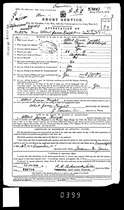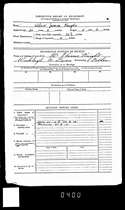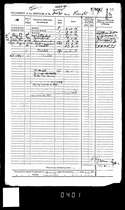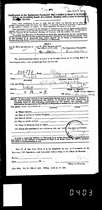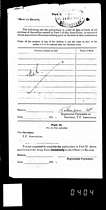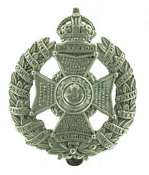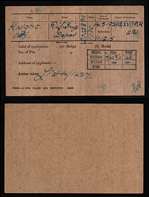Albert Knight was born in 1896 in Winkleigh, the third child of Thomas Knight (born in 1865) and his wife Elizabeth who was 5 years older than Thomas. The 1901census records the family living in Lowertown, Winkleigh: Thomas (an agricultural labourer), Elizabeth, and the children, William aged 12 (born in Wembworthy), John, 7, (born in Broadwoodkelly), Albert, 5, and Helena, just 2, (both born in Winkleigh). The 1911 census shows the family still living in Lowertown, with William now a 23 year old labourer, John working elsewhere, Albert having left school and now an errand boy, with Helena of course still at school. Not satisfied that his education was completed, the Western Times reported on 22nd May 1914 that Albert Jones had been commended at the prize-giving of the Evening Continuation Classes then established at the school, along with other family members of Winkleigh society, Fred Saunders, Albert Mitchell, Claude Francis, William Baker and Harry Davey. The Knight family contributed to the war with all three sons serving, John in the Life Guards, William in the Devons, while Albert was recruited after his initial training into the Rifle Brigade.
We are fortunate that owing to the fact that Albert was obviously either wounded or sick in early 1918, a selection of his military records have survived in the Pension Records, the general records having been destroyed in the London blitz. Together of course with the war diaries of the 10th and 11th Battalions of the Rifle Brigade, we have enough to reconstruct a large measure of his military history. The military documents are attached to this account, numbers 1 – 6. Referred to in the text they can be immediately referred to.
1. Attestation and enlistment.
2. Descriptive report on enlistment.
3. Regimental conduct sheet.
4. Statement of services.
5. Netley Hospital invalidating board.
6. Record of no children born to Albert Knight.
We are also extremely fortunate that the entire war diary of the two battalions in which Albert served in France have survived - the 11th and then the 10th Battalions of the Rifle Brigade, an ‘elite’ regiment that recorded with great clarity the day to day events that befell their battalions, together with (in the case of the 10th and 11th) hoarding virtually complete casualty lists recording every man by name, extremely rare in documents surviving the First World War. In repeated cycles of almost complete destruction, rebuilding followed by further destruction and so on, these two war diaries can be read as a microcosm of all the horror of the war on the Western Front.
Albert Knight’s military career began when he attested under the Derby scheme on 10th December 1915. Albert had chosen the very last minute to do so.
On 11 October 1915 Lord Derby was appointed Director-General of Recruiting. He brought forward a programme five days later, often called the Derby Scheme although its official title was the Group Scheme, for raising the numbers. Men aged 18 to 40 were informed that under the scheme they could continue to enlist voluntarily or attest with an obligation to come if called up later on. The War Office notified the public that voluntary enlistment would soon cease and that the last day of registration would be 15 December 1915.
Albert was 19 years old, ready to follow his brothers - John, already in the 1st Life Guards and Willie in the Devons. Single men were called up first: Albert, in Group 2, one of the first. The story is recoded on Document 1, called to the colours on 23rd January 1916. Meanwhile, with the Derby scheme only a partial success, the Military Service Act of 27 January 1916 brought conscription into effect for the first time in the war. Along with the Defence of the Realm Act, it was possibly the most important piece of legislation in placing Britain onto a "total war" footing.
Document 1 shows us that no longer an errand boy, Albert is now described as a carpenter, which means he was possibly serving his apprenticeship with the Inch family in Winkleigh. Document 2 confirms that in January 1916 he was 20 years and 2 months old, and that from 24th January to 30th August 1916 he was in training at home, before moving to France on 31st August. Albert’s medal card, shown attached, records the number 200289 he had been given when posted to the 17th Battalion of the Rifle Brigade. Albert was an excellent soldier: his conduct sheet (Document 3) when demobilised in February 1919 shows a clear record.
Document 4 reveals his military history. As for the first volunteers, the Derby men were allowed to express a preference for their form of service but this time there was no guarantee that their choice would be allowed. Whatever he had asked for at the time of attestation, Albert Knight was first enlisted into the 9th Battalion Somerset Light Infantry on the 25th January 1916, where he was given his basic training before being posted to the Rifle Brigade. The 9th (Service) Battalion of the Somerset Light Infantry had been formed in Plymouth in October 1914 as part of K4, the fourth army to be raised in response to Lord Kitchener’s appeal for the 4th hundred thousand to volunteer. On 10th April 1915 the battalion was listed as the SLI reserve training battalion for new recruits. Albert was at least able to serve not too far from Winkleigh and no doubt was able to get home whenever possible for short term passes.
Now classified as a trained soldier, Albert found himself transferred to the 3rd/4th Battalion of the Royal
West Kents, which had originally been formed on 14th June 1915 from the remaining portion of the original 2/4th Territorial Battalion that had not been transferred into a new "Kent Composite Battalion". It was now to become part of the army in France, but needed a massive influx of newly trained men to build it up to fighting strength. This process did not reach completion until 1st June 1917 when it landed at Le Havre. However, Albert did not stay with the battalion for long. As a result of the severe casualties experienced by the Rifle Brigade, urgent reinforcements were needed and on 28th August 1916 Albert was transferred into their 20th Reserve Battalion at Blackheath, to be sent to France on 31st to join the 17th Battalion Rifle Brigade which had been in France since March 1915. Immediately on arrival he was posted to the 10th Battalion, which had been in France since July 1915. The 10th belonged to the 59th Brigade of the 20th (Light) Division, working alongside the 11th Battalion, and sharing the same Brigade with the 10th and 11th Kings Royal Rifle Corps, all constantly referred to in the 10th Battalion War-Diary.
The 20th Division was withdrawn after the heavy fighting of the Somme battles, moving on 20 April 1918 to an area south west of Amiens. During the summer months it received many new drafts of men, including of course Albert Knight. Rebuilt, the Division took part in the Passchendaele offensive (the main central area leading up to the key position of Langemarck), and then in November 1917 the battle of Cambrai. March 1918 decimated the Division resisting the great German offensive, but it was just before this time, in February 1918, that the 10th Battalion was closed down entirely, the officers and men dispersed to other battalions of the Rifle Brigade or the K.R.R.C. Albert was posted to the 11th Battalion of the Rifle Brigade, so he must have felt the ‘destruction’ of the 10th a little less keenly than others less fortunate. The 11th was virtually wiped out resisting the German offensive: somehow Albert managed to survive to become part of the nucleus rebuilding the battalion. It appears that he was either wounded or fell sick on or just before 1st August 1918, and was posted, probably to Netley Military Hospital. Recovered, he was finally discharged on 14th March 1919, having been awarded a pension.
The war-diary of the 10th Battalion Rifle Brigade from the 27th September 1916, 59th Brigade, 20th Division, (WO95/2117-1-2) informs us of what happened to Albert Knight after he joined the battalion. The 10th had been involved in a nasty little action in front of Guillemont a few days before which had resulted in large casualties, and new drafts were needed. The conditions in this part of the Somme battlefields were appalling. In the trenches N.E. of Guinchy just before Albert’s arrival, life in the wrecked trenches was almost unbearable. There was no shelter and men were standing in mud up to the knees, suffering intense shelling. On September 20th relief came by motor lorry to a camp S.E. of Meaulte and then to comfortable billets in Morlancourt. The line was taken over by the French, and the 10th then bivouacked without much cover between Carnoy and Maricourt. Here, on 28th new drafts arrived, amounting to 149 other ranks, and on 29th a further 308 arrived. The next day all the new arrivals were paraded for the Brigadier to inspect at Brigade H.Q. There was no doubt a ‘pep talk’./p>
For the first few days of October 1916 the 10th were in rest in the Carnoy valley and Trones wood. The new drafts were being trained, Lewis Gunners, Signallers, Bombers. 355 men were sent up as working parties at night, through the incessant rain. On 4th the 59th Brigade were all in the front line, knee deep in mud, south of Guedecourt, and digging new communication trenches. On 6th October they were relieved to dirty and crowded billets South of Meaulte and then to Mericourt at last for some rest, only to clean up for the Corps Commander’s parade. Rest and training continued for the rest of the month in various billets, preparing for the 20th Divisional sports with some lucky ones getting a pass to visit Amiens.
Rest continued during November 1916. The Brigade Sports day was held but no trophies were won. Instead the 10th were selected for a ‘show’ mock attack in front of the Brigadier and Divisional Commander at Ailly, where they performed well. Then, moving from billet to billet, sometimes in French busses, the 10th were employed in further carrying parties at night and working on the smashed roads, employment relieved only by much training in bayonet fighting. By 28th October the 10th were in Mansell Camp, near Mametz, for road working. Here the officers slept in huts, while the men were soaked in muddy tents without even floorboards to lie on. Life continued in this way until the 8th December. On 9th the 10th moved up the line for an exhausting two day turn in the front line. The so-called ‘battlefield trenches’, that is with no wooden revetting, were merely ditches of mud and water. Snow fell in a blizzard. Hundreds fell sick and on 12th they were relieved back to Guillemont and on to a hutted camp at Carnoy in a state of extreme exhaustion. On 15th it was back to those ruined ditches again for another two days before the shelter again of the Carnoy huts. So it continued, two days in, two out, until on 24th misery was relieved by relief by train to Corbie to celebrate Christmas, and two further days of real rest.
On the 4th January 1917 the 10th moved up the line, this time into no trenches at all, only isolated posts. The Germans were very close but it was ‘live and let live’ - indeed the whole of January was a time of little action, in and out of the line, two or three days at a time but always in intense cold. Impossible to dig in the rock-hard ground, both sides were concentrating on survival. In or out of the line, in trenches, pot-holes or billets, there was no fuel, no way of keeping warm. On 12th February there was a real rest for four days at Carnoy but back in the line the Germans were intensifying their use of trench-mortars and machine-gun fire, causing more casualties, and experiments were being made in the use of flame-throwers for attack, a new horror that was to be used extensively in 1918. On the 18th February a single post was attacked: the officer was burnt alive and a man taken prisoner.
The thaw began on 22nd February and the whole area turned into freezing mud. During the month both sides began to stir into action in the Guillemont area. On 28th March Brigade ordered a general attack by three battalions at Etricourt. Nothing was gained but in the 10th 2 officers and 38 other ranks were wounded. The line taken by Brigade was extended in April, covering a mile long and patrols moved forward aggressively towards Metz, but thankfully a Divisional rest began on 5th and the 10th moved back to the region of Havrincourt Wood.
High Command had begun to realise that with the Germans entrenched behind their new and seemingly impossibly strong Hindenburg Line, the task for the future would be both arduous and very different from the endless siege warfare of trench life. Lessons had to be learnt on attacking strong points, and new training introduced. On May 1st number 7 platoon, B Company, gave the Brigade a demonstration, using live ammunition and grenades. Thankfully, no one was injured. The new box respirators had been issued and had to be tested – another new twist to how events were shaping.
Rest over, the 10th were back in the line on 17th May, relieving their sister the 11th Battalion. Tours were now extended to 4 or 5 days in the line, 4 or 5 in rest. The June weather was idyllic. In rest at Vaux-Vrancourt the new sport was ‘Russian wrestling’, introduced by a real Russian wrestler who had somehow got himself enlisted in the British army, and became something of a novelty to the 10th. On June 9th 1917 more serious soldering began when the 10th occupied a line that faced the first outposts of the Hindenburg Line opposite Bullecourt and Riencourt. Gas was to be used for a probing attack, and on 17th June 300 men carried the heavy gas cylinders to the front line, to be discharged by the Royal Engineers. On 21st the gas was discharged but the attack was itself cancelled: of course the Germans replied with retaliatory shelling, fully expecting action. Casualties resulted.
There was to no more action for the time-being, as on the 29th June 1917 the whole 20th Division moved into Divisional rest, the 10th settling first at Faureuil to send up the line working parties of 285 at a time for the next three days, but then to Gommecourt outside Bapaume and finally by train from Achiet-le-Grand to Bruneuel. In the fine weather of July 1917, the 10th were training for their next battle to come, involved in the Passchendaele campaign on the middle axis of the advance, the attack on the vital strategic village of Langemarck. The new recruits were trained in bombing, rifle-grenades, the Lewis Gun, signalling, sniping, scouting and musketry, and following a move to Proven the whole battalion exercised in attack. There was a Brigade sports day and on 25th July came the final selection of the 8 Officers and 108 ORs that were to be left out of the coming attack, the so-called ‘battle nucleus’ around which a destroyed battalion could be rebuilt. On July 29th they were in the line: many lives were saved by the new box respirators, which protected from a new form of gas released slowly and imperceptibly. Even so, there were some 30 gas casualties and 5 men died.
In reserve from 1st – 8th August, the weather unseasonably cold and wet, the 10th were building huge dumps of ammunition and carrying up supplies to the front line. Their task ahead was formidable, an attack across the Steinbeck stream, just fordable if necessary but slippery with deep mud, to attack well-entrenched machine-gun positions on the East bank. Success would open the way the following day for the capture of Langemarck, vital to the whole advance. At 4.00am zero on 14th the 10th advanced 250 yards to the stream, only to find that their portable bridges were too short and many men were killed fording in the mud. Nevertheless the men gallantly pushed forward to a line 250 yards east of the crossing. By 6.00 am all the Company Commanders had been killed or wounded. 20 ORs had been killed, 155 wounded, 15 were missing from shell fire and more were dying from sniper fire. The line was somehow held together by the junior officers, thankfully with no German counter-attack. 13 Officers in all were by now killed or wounded, but the battalion had made it possible for the village of Langemarck to be captured by the 60th and 61st Brigades passing through their line on the night of 15th/16th. Those men that remained moved into rest at Proven to receive and retrain new drafts of officers and men. On 24th August the Corps Commander inspected the battalion, congratulating them on a vital success.
The Passchendaele offensive crept slowly forward through the rain and the endless mud, the ground destroyed and unrecognizable. Once again the 10th and 11th Battalions of the Rifle Brigade were destined to return to the slaughter. At Proven new drafts arrived, and plans were made for the advance east of Langemarck. A particularly nasty and difficult defensive line had to be overcome, called ‘Eagle Trench’, not so much a trench as a series of defensive positions. 59th Brigade was given the task and between September 2nd and 7th the 10th moved to Herzeele for specialized training for the attack. By 19th September the 10th was in the line just east of Langemarck, ready for zero at 5.20am on 20th. The initial task was given to the 11th Battalion, with the 10th in reserve, ‘D’ Company of the 10th in support. The attack failed. The 10th took over the front line for the renewed attack on 22nd, this time to be supported by 2 tanks. Unfortunately the tanks bogged down in the mud and again the attack failed. Brigade then ordered the 10th to attack anyway the following day, at 7.00am, a surprise attack without a preliminary barrage. With the aid of an intensive mortar barrage only, the battalion attacked with both a frontal and a flanking movement, and achieved a complete success, following which a German counter attack was repulsed with heavy enemy casualties. 94 prisoners and 9 machine guns were captured, but the price was heavy: 1 officer was killed, 2 wounded and 1 gassed. 120 ORs were casualties, of whom about 30 died. Eagle Trench was a proud honour for the 10th, and it is interesting that while complicated Brigade plans had failed, the 10th had succeeded because the CO was allowed to plan the attack himself, knowing the ground in detail.
The 10th were now completely exhausted and could take no further part in the offensive. New drafts had to be trained, officers replaced, men allowed to recover. They moved back, Ypres, Poperinghe, then Bapaume to Beaulencourt, and finally Hendicourt. The new men were given an 8 day ‘taster’ of trench life at La Vacquerie opposite part of the Hindenburg line, a very quiet area where the only shooting was of the partridges enjoyed by all. Another quiet area in front of Gouzencourt in support to the KRRC gave opportunities for baths and the issue of winter underclothing.
The first half of November passed in similar fashion. But plans were afoot for the battle of Cambrai, and once again the now renewed 59th Brigade was to be in the front line, but this time in support of the main attack. The quiet area at La Vacquerie was at 6.20 am zero on 20th November 1917 suddenly to become a major battle area, in an operation famous for the first use of mass tanks, an artillery bombardment without giving advance warning by ‘registering’ and (as remarked in the war diary) ‘for the first time a serious attempt at secrecy’. On 22nd November the 10th followed through the initial advance to form a defensive flank to cover the advance towards Masoneres and Marcoing, and seizing the crossing of the St. Quentin canal south-east of Les Rues des Vignes. 10 tanks were attached to the 59th Brigade, and between the four battalions Les Rues des Vignes was cleared. In the 10th two Company Commanders were killed and 24 ORs. 3 officers were wounded and 20 ORs were missing. On 23rd the 10th moved back to support, on 25th to Divisional reserve, but back into the line on 29th. Then the blow fell. A ferocious German counter-attack between 30th November and 3rd December drove the British Divisions virtually back to their starting lines, turning their flanks into a wholesale retreat. In 10th shell fire destroyed the HQ, with every officer (including the Colonel) killed or wounded. Control broke down, Companies isolated, shelled, machine-gunned and strafed from the air. With the enemy bombing down the trenches, the 10th ran out of bombs and without ammunition just managed to withdraw to their original start trenches. On December 4th, shelled again with gas and high explosive, they were relieved to the original support line. Two officers and 7 ORs had been killed, 1 officer and 78 ORs wounded, but the Colonel, the adjutant and two HQ officers together with 161 ORs were missing, killed by shell fire. Yet again the Battalion had been destroyed, and as it turned out, this time almost for good.
It was to survive for a short while longer. Moving first to Ypres, then Albert, and further back to Humbert, there was six days of rest from 6th – 11th December, marked by very bad weather. The next move was to Sabloniere, where the battalion stayed over Christmas from December 11th to 27th. Training was limited due to an extreme shortage of NCOs and specialists, besides very few officers. All the Companies were as yet commanded by 2nd/Lieutenants. Snow fell, the roads were frozen, but from 27th
when reinforcements began to arrive the battalion was employed building a new Corps reserve line. As the year turned reinforcements were drafted in - a new batch of junior officers, and men, untrained as infantry, combed out from the Army Service Corps. As yet far from being able to go into the line, the battalion now numbered 20 Officers and 540 ORs.
1918 found the 10th back in the Ypres area building a light railway at Dickibusch, and on salvaging parties near the line in the Menin road/ Polderhoek area. From January 7th-13th they were in camp at Stirling Castle and used as carrying parties. There were ‘acclimatization’ periods in quiet areas, 14th to 16th in dreadful trenches in equally dreadful weather, or in reserve to the Brigade in nothing but dugouts and groundsheets at Swan Chateau. There were now 34 Officers and 608 ORs, time for the Brigadier’s inspection on 23rd, and as compensation a visit on the same day by the Divisional concert party, the ‘Very Lights’. Two day practices in the front line (the same awful dugouts) took up the rest of the month before moving to Divisional reserve at Chippewa Camp on 30th. Little did they know what awaited them.
On 3rd February news was received that the 10th Battalion would be immediately disbanded, literally overnight. What the Germans had failed to do on numerous occasions, Division achieved at a stroke. The news was a terrible shock: soldiers ‘belong’ to their battalion, their ‘home’. The Battalio0n was up to strength, 45 officers and 858 ORs. Now all were to be separated. Within hours complete Companies were posted to other battalions within the Brigade. Albert Knight was lucky. He was posted (Document 4) to the 11th Battalion, to be with many men of the same regiment with whom the 10th had worked for so long. On 4th February he arrived at Ontario Camp, Reinhelst.
It is worth quoting the war-diary of 10th Battalion if only to record the apparently off-hand way in which the Battalion was treated by the Staff, and the desperate sense of pride which marked its demise.
‘Considerable disappointment was caused by the fact that neither the Divisional Commander nor the Brigadier could find time to address the officers and men on this most important occasion, but it was quite understood that owing to the importance of completing the disbandment as quickly as possible this was almost impossible.’
A summary of the Battalion’s history followed, which can be taken as a summary of Albert Knight’s service from 27th September 1916 up to that time. Reading this his survival was indeed most remarkable.
‘Thus has the Battalion been cut short. It was raised on 26th September and came to France on Jul y 21st 1915 and after a probationary period in the Ypres sector, took part with great distinction in the Somme battle of Guillemont on September 3rd 1916. In 1917 the Battalion fought in front of Metz and Havrincourt Wood, on March 30th gaining the high ground in front of these places and so enabling a further attack to be launched to capture the village and outskirts of the wood (April 4th 1917). On August 14th/15th 1917 the Battalion, in conjunction with the 11th Rifle Brigade forced the passage of the Steinbeck preparatory to the taking of Langemarck by the 20th Division, and on August 23rd captured Eagle Trench in front of Langemarck* taking 8 machine guns and 90 ‘sturmtruppen’ prisoner. On November 20th and on succeeding days the Battalion took part in the attack near Cambrai. The Battalion was one of the strongest in the Division and had quite recovered from the momentary shaking it had received when the Hun attacked in the Cambrai area. Sic transit Gloria mundi. Yet the Battalion’s memory will never die.’
*Eagle Trench was in fact east of Langemarck.
One might add that this web-site account has done something to preserve this memory of the 10th Battalion, and honour the hundreds of men who died cherishing it.
It was in this way that Albert Knight was posted to the 11th, sister battalion of the 10th, on 4th February 1918. He arrived in time for the great German offensive which began on March 21st 1918, which caused horrendous casualties on both sides and almost resulted in Germany winning the war. The 11th Battalion of the Rifle Brigade was caught up in the great retreat and the defence of Amiens and was completely destroyed. It was only by the most amazing good fortune that once again Albert Knight survived, one of the very few lucky ones.
On 11th November 1917 Ludendorff had presided at a conference at Mons to determine how best to bring about a German victory in 1918 – by a thrust westwards against the British or southwards against the French. The Germans had not got the resources for both at once. Since the British army was now the dominant partner of the alliance, it was decided that the attack must fall on the British lines. A new and devastating method of attack was designed to follow the initial overwhelming barrage. This was the use of Storm Troops, armed with light machine guns, flame throwers and light trench mortars, to cross the trench lines, by-pass machine gun posts and destroy the artillery. New signaling methods were devised to allow the forward infantry to signal and control the creeping barrage (rather than to follow a pre-arranged timetable that most often broke down), an entirely new concept in the First World War. Battle-units would follow the Storm-Troopers to secure the areas captured.
Code-named ‘Michael’, with huge forces concentrated behind the immensely strong Hindenburg Line, the first attacks were launched from Armentieres in the north to the junction of the British and a joint Franco-British front at Barisis in the south, just above the river Oise. Just before five o’clock on the morning of March 21st began the most concentrated artillery bombardment the world had ever seen. Six thousand German guns opened fire simultaneously along a forty mile front between the Sensee River and the Oise, and the entire battle-zone collapsed under the weight and volume of fire and gas mixed with the morning fog and the smoke of battle. 52 German divisions supported by 12 reserve divisions attacked the British 3rd and 5th Armies. The attack was held by the 3rd Army but broke through the weak 5th Army which held a 42 mile front with only 14 divisions (the 3rd Army had 16 divisions on a 28 mile front). In the following ten days the Germans advanced 80 kilometers, reaching within 100 kilometers of Paris. However, losses were horrific, the Germans sustaining over 250,000 casualties, the British 10,000. The second German offensive, known as Operation Georgette, began on April 9th to the south of Ypres just to the east of Armentieres, aiming to drive the British back to the Channel ports. With his ‘Backs to the Wall’ order of the day, Haig ordered that every position must be held to the last man. The Battle of the Lys, as this campaign became known resulted in 109,000 German casualties, 76,000 British and 6,000 Portuguese. The third great offensive, Operation Blucher, began on May 27th against the French from Soissons, along the Chemin de Dames as far as Reims. After crossing the Aisne and advancing towards the Marne, General Foch counter-attacked. The German retreat began. With barely any reserves left and supplies and munitions at an all-time low, the morale of the German army finally disintegrated, and the great offensive was over.
The 11th Battalion of the Rifle Brigade was virtually wiped out in the frantic defence of the Amiens sector. If the town had fallen it is likely that the Germans would have broken through to the Channel ports and the war would have been lost. Albert Knight was extremely lucky to have survived, but having done so his war was virtually over. The 11th had suffered even worse than the 10th and for them it was a question of re-building an entirely new battalion from scratch, and this with only half-trained and totally inexperienced under-age boys, together with a batch of newly-commissioned young officers. Any kind of hard battle experience for the 11th would be out of the question for many months, but it was invaluable that the few battle-hardened and experienced survivors that remained could form a tiny nucleus of the new battalion.
The story of 11th Battalion and its destruction makes dramatic reading, even in the outline of events recorded in the war diary (WO95/2116/5). Well aware of the impending catastrophe that was expected to fall on them, Gough’s 5th Army was making every last-minute effort to establish the best defensive positions possible. There were rumors and counter-rumors, reflected in the movements of 11th immediately prior to the attack. At the end of February the 11th were in position at Candor between St.Quentin and Amiens. The day after the great German offensive had begun, the 11th withdrew to the West of the Somme Canal, to defend the crossing by the bridge at Bethancourt, which was blown by the Royal Engineers. The canal bank was intended as a very important defensive position, but the battle that resulted marked the destruction of the 11th. Attempts by the Germans to build a pontoon bridge were initially repulsed causing the enemy many casualties, and French reinforcements came up to assist in taking other positions that had been lost, but the defences were overwhelmed. Extensive casualties were caused by our own artillery falling short on to the 11th positions and on 25th/26th a night retirement was ordered to fall back on Roye and Quesnal where another so-called defensive position was prepared on high ground. Brigade ordered a counter-attack to try and re-take the canal position. The result was not just a failure but the virtual extinction of the whole of ‘A’ Company. 1 officer and 25 men remained. ‘B’ and ‘C’ Companies had lost all their officers by this time, while I officer survived in ‘D’. The higher ground position was held on 27th for a few hours, but the sacrifice was now virtually complete, and the few that remained were finally withdrawn to join other remnants of troops on the Amiens-Roye road, in immediate support of the ‘front line’ running from Courcelles to behind Mezieres. A counter-attack was ordered to take Mezieres: this failed. After falling back again, the line was held on 29th-31st March by a mixture of the 20th Division remnants and some mixed-up French troops. A further retreat was ordered on 31st to fall back across the Luce River to a new line. On 1st April the ‘Battalion’ went into reserve, taken back in a couple of French lorries through Amiens to Selincourt Camp. Heroic efforts by the 20th Division and many other French units had secured the saving of Amiens: the Germans had run out of both supplies and reinforcements and the immediate crisis was over.
The 11th Battalion war Diary relates with bitterness the confusion that they had endured and the panic which had seized both Brigade and Division headquarters. The Battalion had been deprived of its own transport and signalling equipment, which had been put under direct orders of Division, with lamentable results. Improvised units from the Headquarters had been rushed forward: cooks, orderlies, stretcher bearers, batmen, clerks etc who were virtually untrained for battle had rifles pushed into their hands and sent forward to join units totally unprepared to assimilate them, instead, as the war-diary comments, of being better used to prepare defensive positions further back to which the fighting troops could retire As a result, men who were already exhausted were expected both to fall back and then to try and dig new cover positions for themselves for a new defensive line.
The endless casualty lists for March are terrible reading. So-called ‘reinforcements’ were rushed out from England to attempt to re-build the battalion. The first drafts of 93 men that arrived almost at once consisted of untrained under-age boys almost straight from their attestation: clearly the country was running out of men, and those who had up to now been in ‘reserved’ occupations would have to be combed-out if the war was ever going to be won. On 10th April there was a move to Warchville and a further 200 men and 3 officers arrived. Then, next day, it was off to Bethancourt-sur-mer for a month of training on the beach. 7 officers and then another 17 arrived with 118 other ranks, and by the end of the month the battalion consisted of 57 officers and 833 other ranks.
Numbers were one thing but a completely new battalion had still to be fully trained, largely by newly-commissioned subalterns, themselves inexperienced. The 11th moved forward to Souchez: the Division had been reorganised and the Battalion was now part of the 60th and 61st Infantry Brigades, holding the Lens-Avion sector. Thankfully, it was to be a time of absolute quiet, an example of total ‘live and let live’ with no action possible on either side, apart from both indulging in gas-shelling, the only kind of offensive action that was possible. ‘Training’ was occasionally extended into some minor trench-raiding to remind everyone that there was a real war on: an attempted raid by ‘A’ Company on 18th May failed because the artillery failed to lift and 7 men were wounded by friendly fire. The tours of duty in the line were usually of 5 to 6 days, with occasional withdrawls to Vimy Ridge to practice on the rifle ranges.
June came and went in much the same way, in and out of the line. On 27th the first experience of ‘Spanish flu’ occurred and many men went sick with the as yet unknown ‘4 day fever’. The Spanish flu struck gently at first: those who caught it were the lucky ones. They recovered and became immune when much more deadly strains of the virus had mutated later in the year. By the end of June the Battalion consisted of 48 officers and 915 ORs, and casualties for the month were 3 men killed and 6 wounded, all the latter gas cases. July brought some relief, at least for the officers, with a Brigade Horse Show and races at Souchez. In anticipation of the British offensive that was to begin in late August, some training had begun on working in co-operation with the 11th Tank Battalion. The month was wet and the troops learnt how to drain their trenches. 1 man had been killed and 7 wounded, either by snipers or gas shells.
August brought rather more activity. The battalion was in the line at Lens. On 3rd there was a moderately successful trench raid by No.7 platoon of ‘B’ Company. There were no casualties and 2 prisoners were taken. This was Albert Knight’s last few weeks with the battalion which was still at full strength and gradually learning how to fight, but during the month 1 officer and 1 man had been killed, 16 ORs wounded and 43 went sick with the Spanish flu.
Albert Knight was evacuated down the line to the UK on 4th February 1918, where he was finally assessed for discharge at the Royal Victoria military hospital, Netley, but we have no clue from the war-diary or his records whether for a wound or sickness. In the 10th Battalion very detailed records of casualties were carefully preserved, but in the re-built 11th Battalion this does not seem to have been the case. Document 5 is our information here. We cannot be absolutely certain that he was treated at Netley, or whether, as the form asserts he was ‘brought before an invaliding board of a Central Hospital with a view to discharge’, in other words treated elsewhere. This did not take place until 11th March 1919, so that his recovery and convalescence had taken some 13 months, which suggests a very serious condition. The document records his service as 3 years and 50 days, and that he was certainly awarded a pension. Albert returned to Winkleigh with great honour: it is with considerable pride in his survival that his service to his country should be always remembered.
16 July 2011


